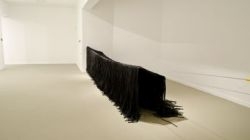
Orly Sever / Eva Hesse
Orly Sever
Born on Kibbutz Cabri, 1976
Lives and works on Kibbutz Cabri
Orly Sever's works build on the conceptual and minimalist language of art during the 1960s and 1970s. From a formal perspective, they echo the works of artists such as Richard Serra or Carl Andre, while her interest in various materials that are simultaneously rigid and fluid recalls Hesse's experimental materiality. The use Sever makes of black plastic designed to seal windows is a tribute of sorts to Eva Hesse's thread works.
Eva Hesse
1936, Hamburg, Germany
1970, New York, USA
Eva Hesse was born into a Jewish family that fled Nazi Germany for New York in 1939. After studying design, art, and architecture, she began working in New York as a textile designer. In 1961, she first exhibited her paintings in museums and galleries. In 1964 she traveled to Germany for a year with her husband, the sculptor Tom Doyle, where she encountered the work of artists such as Joseph Beuys, and began working in three dimensions. In 1965, the two returned to New York, and separated a short time later. From 1965 onwards, Hesse focused on sculpture and experimented with unconventional techniques and materials, such as Latex and Fiberglass, while continuing to draw. She was one of the few women active in the Conceptual and Minimalist art world of the time, and participated in important exhibitions such as "When Attitudes Become Form" (Bern, 1969). Art was the center of her life; as she wrote in her journal, "In my inner soul, art and life are inseparable." In 1970, when she was 34 years old, she died of a brain tumor.